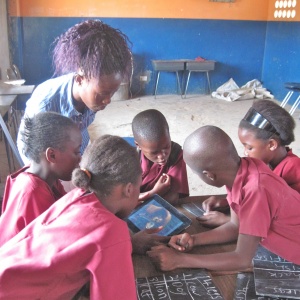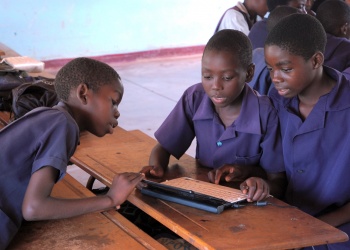OER4Schools/XO familiarisation: Difference between revisions
From OER in Education
No edit summary |
No edit summary |
||
| Line 12: | Line 12: | ||
# '''Exploration of turning on a computer. '''Allow pupils to figure out how to turn them on (find the power button). The pupils should be discussing in the groups. Encourage them e.g. by making analogies with other electrical devices. If they are stuck, show one group, and ask that group to show others. When they have managed to turn on the computers, they should observe what happens: when XO is being opened for the first time, you have to login by writing your name. Remember that faster groups should help slower groups. | # '''Exploration of turning on a computer. '''Allow pupils to figure out how to turn them on (find the power button). The pupils should be discussing in the groups. Encourage them e.g. by making analogies with other electrical devices. If they are stuck, show one group, and ask that group to show others. When they have managed to turn on the computers, they should observe what happens: when XO is being opened for the first time, you have to login by writing your name. Remember that faster groups should help slower groups. | ||
# '''Exploration of the login screen. '''Ask groups: What do you need to do next? What do the parts of the XO do? Can you give names to the parts? Give them plenty of time to discover and press things on the XO, without telling them. They can’t really break anything if they are careful. Let them help each other and discuss with each other what they are finding out. | # '''Exploration of the login screen. '''Ask groups: What do you need to do next? What do the parts of the XO do? Can you give names to the parts? Give them plenty of time to discover and press things on the XO, without telling them. They can’t really break anything if they are careful. Let them help each other and discuss with each other what they are finding out. | ||
# '''Exploration of the desktop. '''They now need to apply their new knowledge: “click” on “username” ''classroom'', and “enter” the “password” ''student. ''They now see the desktop. When a group is ready to move to the next stage, the teacher demonstrates how to open a web browser (to that group). Ask the students to do the same. Again, the students find out what happens. Don’t worry if they can’t open the web browser - let them try to open whatever applications they like. Then after a while repeat the instructions about opening a web browser to the same group. Again, get the groups to help each other find how to open the browser. They should immediately share anything they find out with the whole class. | # '''Exploration of the desktop. '''They now need to apply their new knowledge: “click” on “username” ''classroom'', and “enter” the “password” ''student. ''They now see the desktop. When a group is ready to move to the next stage, the teacher demonstrates how to open a web browser (to that group). Ask the students to do the same. Again, the students find out what happens. Don’t worry if they can’t open the web browser - let them try to open whatever applications they like. Then after a while repeat the instructions about opening a web browser to the same group. Again, get the groups to help each other find how to open the browser. They should immediately share anything they find out with the whole class. | ||
Revision as of 15:06, 19 November 2014
| Resource details | |
| Title | XO familiarisation |
| Topic | |
| Teaching approach | |
| Learning Objectives | |
| Format / structure | |
| Subject | |
| Age of students / grade | |
| Table of contents | |
| Additional Resources/material needed | |
| Useful information | |
| Related ORBIT Wiki Resources | |
| Other (e.g. time frame) | |
| Files and resources to view and download | |
| Acknowledgement | This resource is part of the OER4Schools programme. |
| License | |
XO familiarisation activity
Take the school XO's to your class - making sure that they are carried and used according to the rules set by the school.
The pupils work in mixed ability groups (with computers distributed evenly). Groups do not need to progress at the same speed: There will be faster groups and slower groups. However, the faster groups should be helping the slower groups. If a fast group has managed to do something, their task is to split up and help others to reach the same stage!
Activity:
- Exploration of turning on a computer. Allow pupils to figure out how to turn them on (find the power button). The pupils should be discussing in the groups. Encourage them e.g. by making analogies with other electrical devices. If they are stuck, show one group, and ask that group to show others. When they have managed to turn on the computers, they should observe what happens: when XO is being opened for the first time, you have to login by writing your name. Remember that faster groups should help slower groups.
- Exploration of the login screen. Ask groups: What do you need to do next? What do the parts of the XO do? Can you give names to the parts? Give them plenty of time to discover and press things on the XO, without telling them. They can’t really break anything if they are careful. Let them help each other and discuss with each other what they are finding out.
- Exploration of the desktop. They now need to apply their new knowledge: “click” on “username” classroom, and “enter” the “password” student. They now see the desktop. When a group is ready to move to the next stage, the teacher demonstrates how to open a web browser (to that group). Ask the students to do the same. Again, the students find out what happens. Don’t worry if they can’t open the web browser - let them try to open whatever applications they like. Then after a while repeat the instructions about opening a web browser to the same group. Again, get the groups to help each other find how to open the browser. They should immediately share anything they find out with the whole class.
This activity is an example of enquiry-based learning, which we will cover in much greater detail later in the OER4Schools programme.


